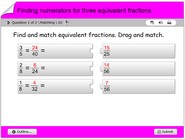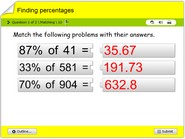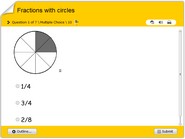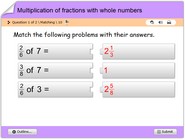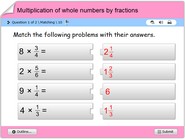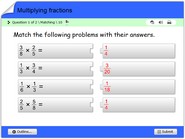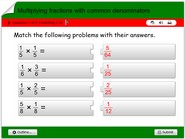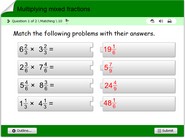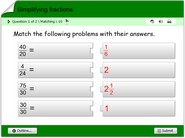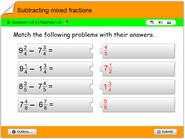Finding numerators for three equivalent fractions quiz
Finding numerators for three equivalent fractions quiz online with easy practice test.
Solving equivalent fraction problems math quiz online
Solving equivalent fraction problems math quiz online. In this quiz, children will test skills on finding the corresponding values of missing numerators or denominators that make a fraction value equivalent or not. This is an interactive online practice game that will supplement math topics on fractions. This game covers skills suitable for 3rd, 4th, 5th, 6th and 7th grade math. Remember this quiz is free and always online but for offline practice there are tons of worksheets fractions4kids has to offer.
When it comes to fractions, equivalent fractions are fractions that have the same value, even though they may look different. For example, 1/2 and 2/4 are equivalent fractions because they both represent the same amount of a whole. In this article, we will learn how to find the numerator (the top number) of equivalent fractions.
First, let’s review the basics of fractions. A fraction is made up of two parts: the numerator and the denominator. The numerator represents the number of parts we have, and the denominator represents the total number of parts in the whole. For example, in the fraction 3/4, the numerator is 3, which means we have 3 parts, and the denominator is 4, which means there are 4 parts in the whole.
Now, let’s talk about equivalent fractions. As we mentioned earlier, equivalent fractions are fractions that have the same value, even though they may look different. One way to create equivalent fractions is by multiplying or dividing both the numerator and the denominator by the same number.
For example, let’s say we have the fraction 3/4. If we want to find an equivalent fraction, we can multiply both the numerator and the denominator by 2. This gives us:
3/4 x 2/2 = 6/8
Now, we have a new fraction: 6/8. This fraction is equivalent to 3/4 because they both represent the same amount of a whole.
Another way to create equivalent fractions is by dividing both the numerator and the denominator by the same number. For example, if we have the fraction 4/5 and we want to find an equivalent fraction, we can divide both the numerator and the denominator by 2. This gives us:
4/5 ÷ 2/2 = 2/2.5
Now, we have a new fraction: 2/2.5. This fraction is equivalent to 4/5 because they both represent the same amount of a whole.
Let’s now practice finding the numerator of equivalent fractions. Imagine we have the fraction 3/5 and we want to find the numerator of an equivalent fraction. We can start by multiplying the numerator and denominator by a common factor such as 2.
3/5 x 2/2 = 6/10
Now, we have a new fraction: 6/10. This fraction is equivalent to 3/5 because they both represent the same amount of a whole. The numerator of this new fraction is 6.
Another way to find the numerator of an equivalent fraction is by simplifying the fraction. When we simplify a fraction, we divide both the numerator and denominator by a common factor to get a fraction in its simplest form. For example, let’s say we have the fraction 12/24 and we want to find the numerator of an equivalent fraction. We can simplify the fraction by dividing both the numerator and denominator by 12.
12/24 ÷ 12/12 = 1/2
Now, we have a new fraction: 1/2. This fraction is equivalent to 12/24 because they both represent the same amount of a whole. The numerator of this new fraction is 1.
In conclusion, finding the numerator of equivalent fractions is an important concept for kids to understand. By multiplying or dividing both the numerator and denominator by the same number or by simplifying the fraction, kids can easily find the numerator of equivalent fractions. With practice and a clear understanding of fractions, kids will be able to use this skill in their everyday life.

